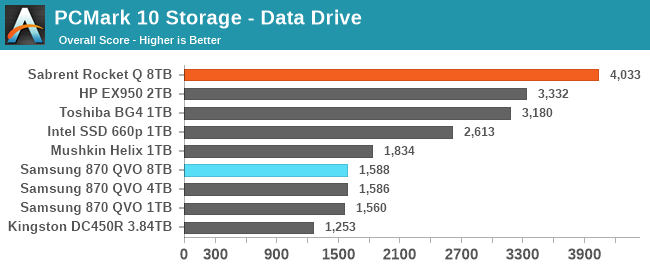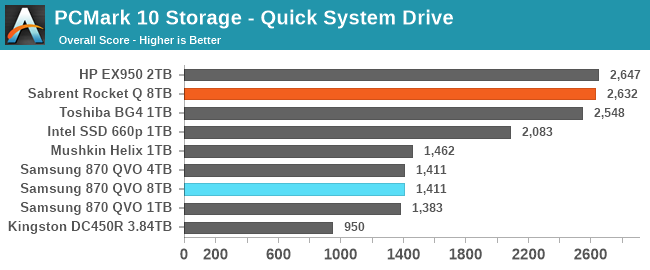QLC Goes To 8TB: Samsung 870 QVO and Sabrent Rocket Q 8TB SSDs Reviewed
by Billy Tallis on December 4, 2020 8:00 AM ESTPCMark 10 Storage Benchmarks
At the end of 2019, UL released a major update to their popular PCMark 10 benchmark suite, adding storage performance tests that had been conspicuously absent for over two years. These new storage benchmarks are similar to our AnandTech Storage Bench (ATSB) tests in that they are composed of traces of real-world IO patterns that are replayed onto the drive under test. We're incorporating these into our new SSD test suite, and including our first batch of results here.
PCMark 10 provides four different storage benchmarks. The Full System Drive, Quick System Drive and Data Drive benchmarks cover similar territory to our ATSB Heavy and Light tests, and all three together take about as long to run as the ATSB Heavy and Light tests combined. The Drive Performance Consistency Test is clearly meant to one-up The Destroyer and also measure the worst-case performance of a drive that is completely full. Due to time constraints, we are not yet attempting to add the Drive Performance Consistency Test to our usual test suite.
| PCMark 10 Storage Tests | ||
| Test Name | Data Written | |
| Data Drive | 15 GB | |
| Quick System Drive | 23 GB | |
| Full System Drive | 204 GB | |
| Drive Performance Consistency | 23 TB + 3x drive capacity | |
The primary subscores for the PCMark 10 Storage benchmarks are average bandwidth and average latency for read and write IOs. These are combined into an overall score by computing the geometric mean of the bandwidth score and the reciprocal of the latency score. PCMark 10 also records more detailed statistics, but we'll dig into those in a later review. These PCMark 10 Storage test runs were conducted on our Coffee Lake testbed:
| AnandTech Coffee Lake SSD Testbed | |
| CPU | Intel Core i7-8700K |
| Motherboard | Gigabyte Aorus H370 Gaming 3 WiFi |
| Chipset | Intel H370 |
| Memory | 2x 8GB Kingston DDR4-2666 |
| Case | In Win C583 |
| Power Supply | Cooler Master G550M |
| OS | Windows 10 64-bit, version 2004 |
Data Drive Benchmark
The Data Drive Benchmark is intended to represent usage a secondary or portable drive may be subject to. This test simulates copying around files, but does not simulate the IO associated with launching and running applications from a drive.
 |
|||||||||
| Overall Score | Average Bandwidth | Average Latency | |||||||
Starting off, the 8TB Sabrent Rocket Q leads the field thanks to its massive and fast SLC cache; it clearly outperforms even the decently high-end 2TB TLC-based HP EX920. The several capacities of the Samsung 870 QVO all performa about the same: less than half the speed of the faster NVMe drives, and slower than the slowest entry-level NVMe drives. The enterprise SATA drive with no SLC caching comes in last place.
Quick System Drive Benchmark
The Quick System Drive Benchmark is a subset of the Full System Drive Benchmark, running only 6 out of the 23 sub-tests from the Full test.
 |
|||||||||
| Overall Score | Average Bandwidth | Average Latency | |||||||
Moving on to the Quick test, the Sabrent Rocket Q no longer stands out ahead of the other NVMe drives, but still offers decent performance. The performance gap between the NVMe drives and the Samsung 870 QVO drives has narrowed slightly, but is still almost a factor of two.
Full System Drive Benchmark
The Full System Drive Benchmark covers a broad range of everyday tasks: booting Windows and starting applications and games, using Office and Adobe applications, and file management. The "Full" in the name does not mean that each drive is filled or that the entire capacity of the drive is tested. Rather, it only indicates that all of the PCMark 10 Storage sub-tests are included in this test.
 |
|||||||||
| Overall Score | Average Bandwidth | Average Latency | |||||||
The Full test starts to bring the downsides of QLC NAND into focus. The Sabrent Rocket Q is now the slowest of the NVMe drives, only moderately faster than the 8TB Samsung 870 QVO. The 1TB 870 QVO is also falling behind the larger and faster models. However, the QLC-based Intel 660p manages to hold on to decent performance, possibly a result of the class-leading SLC cache performance we usually see from Silicon Motion NVMe controllers paired with Intel/Micron flash.










150 Comments
View All Comments
Oxford Guy - Tuesday, December 8, 2020 - link
Samsung doing it isn’t shocking. It’s Samsung after all.Palorim12 - Monday, December 14, 2020 - link
idk if you remember when they did the change from TLC to 3-bit MLC, but I member. It was after all that stuff went down with the 840 EVO. Despite all TLC having this issue across all brands, Samsung was the first to push TLC, so when the slow down issue creeped up, Samsung got the brunt of the complaints, and ppl to this day will use that as a reason as why Samsung "sucks", despite the fact that the issue started creeping up on sandisk and other TLC drives that had entered the market much later after Samsung did. And by the time Samsung figured out the problem and fixed it, all the other manufacturers copied the fix and then really started pushing their own TLC products.And TBH, TLC products since then have been pretty good. I recommend 850 EVOs, and now 860 EVOs to all my friends who want to switch to SSDs but are worried about the price. I've only recommended 2-bit MLC drives to ppl who I know will hit the drive had with writes with the type of work they do.
at_clucks - Wednesday, December 9, 2020 - link
@shabby, other companies have done worse if you ask me, like switching from MLC to TLC mid way through a product's run. Good luck with identifying the exact type of NAND based on decoding a SN without having the decoder ring, especially when the product is still in the store's warehouse.phoenix_rizzen - Monday, December 7, 2020 - link
Switching to a number would really simplify things.1LC
2LC
3LC
4LC
...
But since when has logic been part of marketing?
Billy Tallis - Monday, December 14, 2020 - link
I've already pretty much decided that if we ever get real products that store 5 bits per cell, I won't use any abbreviations that don't include the numeral 5. Stuff like 3bpc, 4bpc, 5bpc would make a lot more sense than current industry conventions.redzo - Tuesday, December 22, 2020 - link
This. It's been a long time since my last post at anand.Consumers have no idea of what they are purchasing. They are basically sheep.
QVO is nice if it is priced right. It should be priced way less.
I just purchased a 3d nand TLC 1TB for less than an intel/crucial/samsung qvo equivalent. This is not right. Manufacturers of NAND flash and product manufacturers are taking advantage of misinformed consumers.
More so. Most products are missing important specs like controller model, dramless or not, or even NAND type. This is just ridiculous.
dontlistentome - Saturday, December 5, 2020 - link
If you want MLC or TLC then buy it - they cost more because they cost more to make. I've just bought a 2TB SSD for the old man - paid the 15% or so extra for TLC over QLC.There's no conspiracy here or evil manufacturers. They do R&D then offer a product and see if consumers buy it. Almost all consumers, even those that claim not to be are driven pricipally by price, hence QLC being populat when the buyer looks at the ticket.
Oxford Guy - Sunday, December 6, 2020 - link
Economy of scale makes your comment fail.DigitalFreak - Monday, December 7, 2020 - link
+1 for your mad rhyming skills.Kangal - Tuesday, December 8, 2020 - link
Lmao.But for real, I thought we would have hit 8TB Sata-SSDs like last year for around USD $650. Instead I'm seeing these still yet to launch proper, and priced around $1,000. It's definitely true the market isn't dominated as much by the consumers, as it is dominated by the actual suppliers.